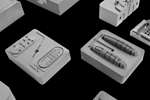The Law of Averages
MoldMaking Technology's 2003 and 2004 Leadtime Leaders discuss the average age of their employees and how this reflects on the industry's future.
Each month the winners of MoldMaking Technology magazine's Leadtime Leader Award competition gather in this monthly column to discuss topical industry subjects. The award-designed to recognize outstanding U.S. moldmaking shops and their ability to succeed in today's global mold market-highlights a number of shops that showed outstanding performance in the following areas: leadtime, current and projected sales growth, innovation in the moldmaking process as well as innovation in the business side of moldmaking, technology, industry involvement and customer service.
This time around, our esteemed Leadtime authorities weigh in on the average age of their employees and the difficulties in attracting younger people to the industry.
Steve Johanns, managing director, business development, Advance Tool, Inc. (Blaine, MN)
We don't keep stats on the age of our employees, but in terms of years of service, the average is somewhere around sixteen years. Without question, the talent pool in the younger generation within this industry is shrinking significantly. It is a challenge that is being faced throughout manufacturing in general. Talent is the most strategic asset to our company. Our goal is to create environment and opportunity for quality people to see a future. For many moldmakers that is an ever-increasing challenge.
Paul Betz, general manager, Century Die Co. (Fremont, OH)
The average age for current employees is 42 and the average age of new hires is 35. Because of our skilled trade younger people usually don't seek us out, unless referred by our local colleges (Terra Technical College/Fremont and Owens Community College/Toledo) or trade schools (Vanguard Vocational/Fremont & Sentinel Center/Tiffin). We have started up our apprenticeship program to fill the needs left by several older retiring employees.
Jason Jepsen, Tech Centre manager, Eimo Americas (Vicksburg, MI)
The average age of our employees is 39+. The average age of our new hires in 2004 is 35. It's important to realize that these numbers reflect the ages of employees across several different departments including: quality, engineering, moldmaking, design, processing, accounting and management. I would have to say that the level of difficulty in recruiting younger people to the industry completely depends on the position you're looking to fill. For example, our engineering leader just returned from Ferris State University, where he was interviewing plastics engineering students for internship/full-time positions. He found no shortage of potential qualified candidates. We were also told that this was to be the largest graduating class in the plastics engineering program that the university had ever seen.
When it comes to recruiting younger people to become moldmakers, however, the situation seems to be much different. I think there are definitely fewer younger people aspiring to be journeyman moldmakers than there were ten years ago. The reason for this is a very complicated topic with many different avenues of debate. Our human resource manager remembers a time when we employed seven different apprentice moldmakers all at once. Currently, we do not have any apprentices or co-op students. We have discovered that part of the issue stems from the educational institutions that have historically supported and cultivated apprenticeship and co-op programs. One reality is that machine shop is often one of the first areas that high schools cut when they work on their budgets each year. Recently, we have also had apprentices have to wait an entire semester to get the college classes they needed to complete their moldmaking certificate, due to class offering reductions.
From my point of view, the future of this trade for young U.S. moldmakers is uncertain at best. There are a number of big issues like offshore competition that quite simply threaten its long-term existence. That's why it is paramount for those of us left to find new ways of staying competitive.
Tim Windingstad, operations manager, M&M Tool & Mold, Inc. (Green Bay, WI)
The average age of our current employees is 34, the average age of employees hired during the last three years is 32+. I have not seen that there has been difficulty attracting younger people to this industry, although I think the profession probably has not been talked up as much the last couple of years. We do host annual tours for a local technical college, so we know there is continued interest.
Gene Bruce, co-owner, Summit Molds, Inc. (Post Falls, ID)
Our average age out in the shop is 37. The last two employees we have hired are 21 and 41. We actually like to hire younger employees if we can, as they have a lot of enthusiasm and seem to be quick to learn the trade as it is today. The last two younger employees we hired had a machining background but no experience in moldmaking. It is definitely harder these days to attract good younger employees into the business simply because the number of shops are down and the demand for manufacturing jobs in general is down due to the Wal-Mart mentality of our society.
Charles Carey, senior vice president, Wentworth Mold, Inc. (Hamilton, ON)
The approximate average age of our employees is 40; the average age of new hires is in the range of age 30. In general, it is a challenge to attract new people to our industry. Keep in mind that there are a number of aspects to our business IT, CAD, CAM, to name a few. Since this technology is more cutting edge and involves computers and programming knowledge, younger people are more apt to apply for, and train, in this area. The conventional side of our business-moldmaking and machining-is probably the area where it has become more difficult. I am personally involved with our local technical college to address this issue. More government funding (Canadian and U.S.) is required in this area to encourage and provide young students with the tools and resources to train with and therefore provide them the ability to walk into companies with above-average knowledge and hopefully a reduced learning curve. This field has a stigma with the younger students of being blue-collar. Although it might not be for everybody, a solid career supported by healthy above-average wages is a reality, and unfortunately, not always realized.
Related Content
Machine Hammer Peening Automates Mold Polishing
A polishing automation solution eliminates hand work, accelerates milling operations and controls surface geometries.
Read MoreConfronting the Mold Design Talent Drought
Recently, I reposted on LinkedIn the results of an informal survey we conducted, which revealed a shortage of skilled mold designers. It quickly gained a lot of traction. Given the response, I thought I'd summarize the feedback and keep the conversation going.
Read MoreMMT Chats: The Connection Between Additive Manufacturing Education and ROI
This MMT Chat continues the conversation with Action Mold and Machining, as two members of the Additive Manufacturing team dig a little deeper into AM education, AM’s return on investment and the facility and equipment requirements to implement AM properly.
Read MoreMMT Chats: Eliminating the Noise to Stay Focused on the Customer
Metro Mold & Design joins me to discuss the value of the 80/20 rule as a business strategy, its talented cross-functional team, the role of automation in mold building and molding, and the continuing impact of COVID-19.
Read MoreRead Next
Molding New Moldmakers
One school—with industry’s help—is a model for our future moldmakers’ education.
Read MoreAre You a Moldmaker Considering 3D Printing? Consider the 3D Printing Workshop at NPE2024
Presentations will cover 3D printing for mold tooling, material innovation, product development, bridge production and full-scale, high-volume additive manufacturing.
Read MoreHow to Use Continuing Education to Remain Competitive in Moldmaking
Continued training helps moldmakers make tooling decisions and properly use the latest cutting tool to efficiently machine high-quality molds.
Read More





















